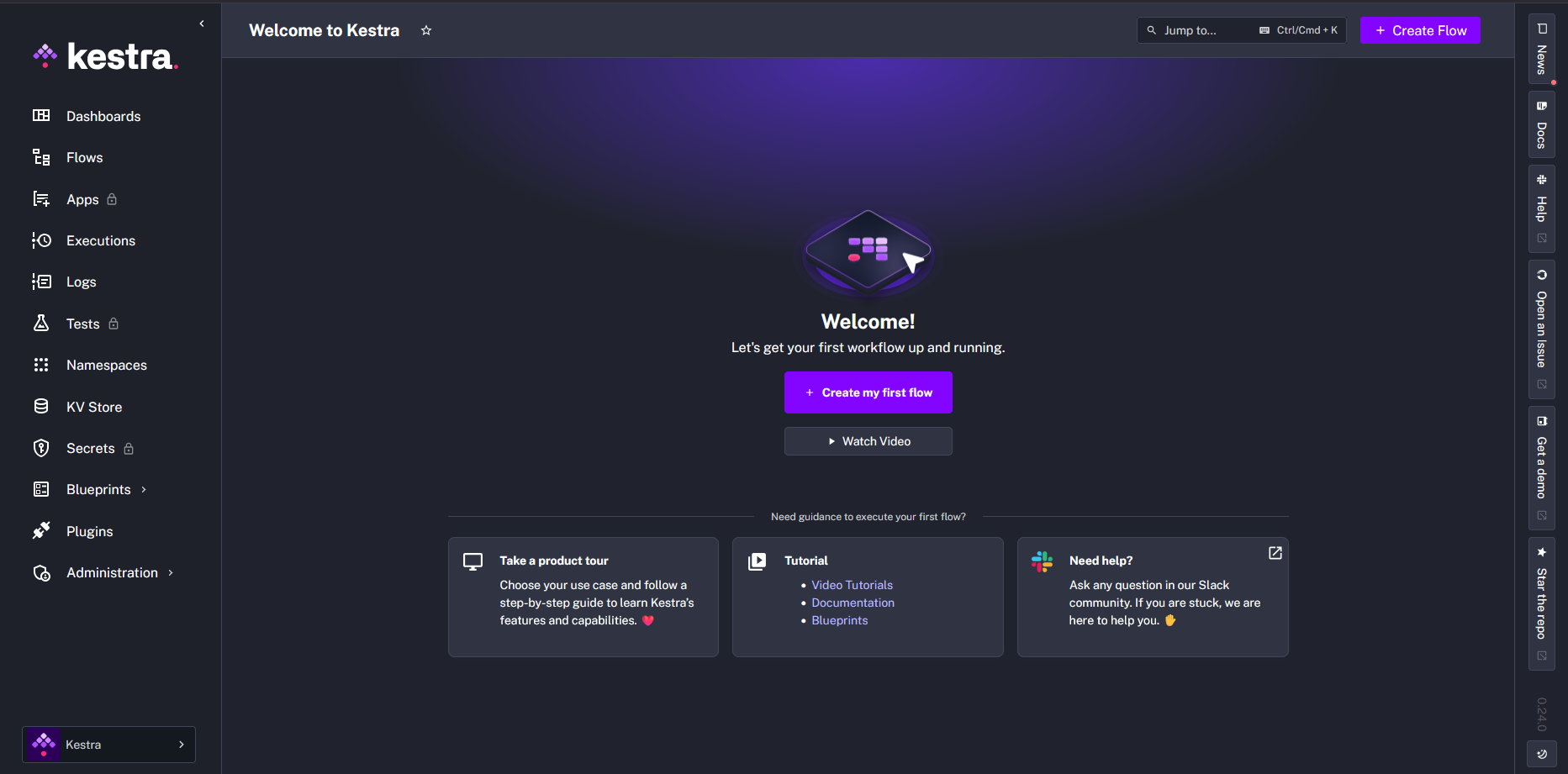📖 Introduction
In modern data engineering and automation, orchestrating workflows is essential. Kestra is an open-source, declarative data orchestration platform that lets you build, schedule, and monitor workflows in a YAML-based format.
Think of Kestra as “automation meets DevOps” — you define tasks, connect them in sequence, and Kestra handles execution, scheduling, and monitoring. Whether you’re managing data pipelines, automating infrastructure, or orchestrating microservices, Kestra provides a powerful yet simple solution.
🔹 Why Use Kestra?
- YAML-based workflows – easy to read, version control friendly
- Beautiful UI – debug and monitor in real-time
- Multiple installation options – Docker, Kubernetes, standalone
- Scalable & cloud-native – from small jobs to enterprise pipelines
- Event-driven & scheduled – automate both scheduled and real-time event-driven workflows
- Rich plugin ecosystem – hundreds of plugins for databases, APIs, and more
- Language agnostic – run code in Python, Node.js, R, Go, Shell, and more
🛠️ Installation Methods
Kestra can be installed in various ways depending on your environment and requirements. Let’s explore the different installation methods.
Method 1: Docker Installation
Prerequisites
- Docker installed
- Internet connection
Single Container Setup
The fastest way to get started with Kestra is using a single Docker container:
1
2
3
| docker run --pull=always --rm -it -p 8080:8080 --user=root \
-v /var/run/docker.sock:/var/run/docker.sock \
-v /tmp:/tmp kestra/kestra:latest server local
|
For Windows PowerShell:
1
2
3
| docker run --pull=always --rm -it -p 8080:8080 --user=root `
-v "/var/run/docker.sock:/var/run/docker.sock" `
-v "C:/Temp:/tmp" kestra/kestra:latest server local
|
Docker Compose Setup (Recommended)
For a more production-ready setup, use Docker Compose:
- Create a
docker-compose.yml file:
1
2
3
4
5
6
7
8
9
10
11
12
13
| services:
kestra:
image: kestra/kestra:latest
container_name: kestra
pull_policy: always
ports:
- "8080:8080"
user: root
volumes:
- /var/run/docker.sock:/var/run/docker.sock
- /tmp:/tmp
command: server local
restart: unless-stopped
|
📜 Show Advanced YAML
1
2
3
4
5
6
7
8
9
10
11
12
13
14
15
16
17
18
19
20
21
22
23
24
25
26
27
28
29
30
31
32
33
34
35
36
37
38
39
40
41
42
43
44
45
46
47
48
49
50
51
52
53
54
55
56
57
| volumes:
postgres-data:
driver: local
kestra-data:
driver: local
services:
postgres:
image: postgres
volumes:
- postgres-data:/var/lib/postgresql/data
environment:
POSTGRES_DB: kestra
POSTGRES_USER: kestra
POSTGRES_PASSWORD: k3str4
healthcheck:
test: ["CMD-SHELL", "pg_isready -d $${POSTGRES_DB} -U $${POSTGRES_USER}"]
interval: 30s
timeout: 10s
retries: 10
kestra:
image: kestra/kestra:latest
pull_policy: always
user: "root"
command: server standalone
volumes:
- kestra-data:/app/storage
- /var/run/docker.sock:/var/run/docker.sock
- /tmp/kestra-wd:/tmp/kestra-wd
environment:
KESTRA_CONFIGURATION: |
datasources:
postgres:
url: jdbc:postgresql://postgres:5432/kestra
driverClassName: org.postgresql.Driver
username: kestra
password: k3str4
kestra:
repository:
type: postgres
storage:
type: local
local:
basePath: "/app/storage"
queue:
type: postgres
tasks:
tmpDir:
path: /tmp/kestra-wd/tmp
url: http://localhost:8080/
ports:
- "8080:8080"
- "8081:8081"
depends_on:
postgres:
condition: service_started
|
- Start Kestra:
- Check logs:
- Access the Kestra dashboard at
http://<your-server-ip>:8080
Method 2: Kubernetes Installation
For production environments, Kubernetes is recommended.
Prerequisites
- Kubernetes cluster
- Helm installed
Installation Steps
- Add the Kestra Helm repository:
1
| helm repo add kestra https://helm.kestra.io/
|
- Install Kestra using Helm:
1
| helm install kestra kestra/kestra
|
- For a custom configuration, create a
values.yaml file and apply it:
1
| helm upgrade kestra kestra/kestra -f values.yaml
|
- Get the pod name to access logs:
1
| export POD_NAME=$(kubectl get pods --namespace default -l "app.kubernetes.io/name=kestra,app.kubernetes.io/instance=kestra,app.kubernetes.io/component=standalone" -o jsonpath="{.items[0].metadata.name}")
|
Advanced Kubernetes Configuration
By default, the Helm chart deploys a standalone Kestra service. For a distributed setup, modify your values.yaml:
1
2
3
4
5
6
7
8
9
10
11
12
13
| deployments:
webserver:
enabled: true
executor:
enabled: true
indexer:
enabled: true
scheduler:
enabled: true
worker:
enabled: true
standalone:
enabled: false
|
You can also deploy related services:
1
2
3
4
5
6
7
8
9
10
11
| # Enable Kafka and Zookeeper
kafka:
enabled: true
# Enable Elasticsearch
elasticsearch:
enabled: true
# Enable PostgreSQL
postgresql:
enabled: true
|
Method 3: Standalone Server Installation
For environments without Docker or Kubernetes, you can use the standalone JAR file.
Prerequisites
Installation Steps
-
Download the latest JAR from the Kestra releases page
-
Make the JAR executable:
- For Linux/MacOS: No changes needed
- For Windows: Rename
kestra-VERSION to kestra-VERSION.bat
-
Run Kestra in local mode:
1
2
3
4
5
| # Linux/MacOS
./kestra-VERSION server local
# Windows
kestra-VERSION.bat server local
|
- For production, run in standalone mode with a configuration file:
1
| ./kestra-VERSION server standalone --config /path/to/config.yml
|
Systemd Service (Linux)
For Linux servers, you can create a systemd service:
1
2
3
4
5
6
7
8
9
10
11
12
13
14
15
16
17
18
19
| [Unit]
Description=Kestra Event-Driven Declarative Orchestrator
Documentation=https://kestra.io/docs/
After=network-online.target
[Service]
Type=simple
ExecStart=/bin/sh <PATH_TO_YOUR_KESTRA_JAR>/kestra-<VERSION> server standalone
User=<KESTRA_UNIX_USER>
Group=<KESTRA_UNIX_GROUP>
RestartSec=5
Restart=always
KillMode=mixed
TimeoutStopSec=150
SuccessExitStatus=143
SyslogIdentifier=kestra
[Install]
WantedBy=multi-user.target
|
🔧 Configuration
Kestra can be configured in several ways:
- Environment Variable: Set the
KESTRA_CONFIGURATION environment variable with YAML content
- Configuration File: Use the
--config option to specify a configuration file
- Default Location: Place a config file at
${HOME}/.kestra/config.yml
Basic Configuration Example
1
2
3
4
5
6
7
8
9
10
11
12
13
| kestra:
repository:
type: postgres
queue:
type: postgres
storage:
type: local
local:
baseDirectory: "/tmp/storage"
postgres:
url: jdbc:postgresql://localhost:5432/kestra
user: kestra
password: k3str4
|
Advanced Configuration
Using Kafka as Queue
1
2
3
4
5
6
7
| kestra:
queue:
type: kafka
kafka:
client:
properties:
bootstrap.servers: "localhost:9092"
|
Configuring Elasticsearch for Indexing
1
2
3
4
5
6
7
8
9
10
11
12
| kestra:
repository:
type: elasticsearch
elasticsearch:
indices:
executions:
index: "kestra_executions"
type: "split_by_month"
flows:
index: "kestra_flows"
templates:
index: "kestra_templates"
|
📋 Workflow Examples
Kestra workflows are defined in YAML format. Let’s look at some examples:
Example 1: Hello World
1
2
3
4
5
6
7
| id: hello_world
namespace: dev
tasks:
- id: say_hello
type: io.kestra.plugin.core.log.Log
message: "Hello, World!"
|
Example 2: Scheduled Workflow
1
2
3
4
5
6
7
8
9
10
11
12
| id: scheduled_hello
namespace: dev
triggers:
- id: schedule
type: io.kestra.core.models.triggers.types.Schedule
cron: "0 * * * *" # Run every hour
tasks:
- id: say_hello
type: io.kestra.plugin.core.log.Log
message: "Hello, it's time for a scheduled task!"
|
Example 3: Data Pipeline with Python
1
2
3
4
5
6
7
8
9
10
11
12
13
14
15
16
17
18
19
20
21
22
23
24
25
26
27
28
| id: python_data_pipeline
namespace: dev
tasks:
- id: fetch_data
type: io.kestra.plugin.core.http.Request
uri: https://api.example.com/data
method: GET
headers:
Content-Type: application/json
- id: process_data
type: io.kestra.plugin.scripts.python.Script
script: |
import json
import pandas as pd
# Get data from previous task
data = json.loads(inputs['fetch_data']['body'])
# Process with pandas
df = pd.DataFrame(data)
result = df.groupby('category').sum().to_json()
# Output results
outputs = {"processed_data": result}
beforeCommands:
- pip install pandas
|
Example 4: Parallel Tasks
1
2
3
4
5
6
7
8
9
10
11
12
13
14
15
16
17
18
19
20
21
22
| id: parallel_workflow
namespace: dev
tasks:
- id: start
type: io.kestra.plugin.core.log.Log
message: "Starting parallel tasks"
- id: parallel
type: io.kestra.core.tasks.flows.Parallel
tasks:
- id: task1
type: io.kestra.plugin.core.log.Log
message: "Running task 1"
- id: task2
type: io.kestra.plugin.core.log.Log
message: "Running task 2"
- id: end
type: io.kestra.plugin.core.log.Log
message: "All parallel tasks completed"
|
Example 5: Error Handling
1
2
3
4
5
6
7
8
9
10
11
12
13
14
15
16
| id: error_handling
namespace: dev
tasks:
- id: might_fail
type: io.kestra.plugin.scripts.shell.Commands
commands:
- exit 1 # This will fail
timeout: PT10S
retry:
maxAttempt: 3
delay: PT1S
errors:
- id: handle_failure
type: io.kestra.plugin.core.log.Log
message: "Task failed, but we're handling it gracefully"
|
🔌 Plugins and Extensions
Kestra’s functionality can be extended through plugins. Here are some popular plugins:
Database Plugins
- PostgreSQL:
io.kestra.plugin:plugin-jdbc-postgresql
- MySQL:
io.kestra.plugin:plugin-jdbc-mysql
- SQL Server:
io.kestra.plugin:plugin-jdbc-sqlserver
Cloud Provider Plugins
- AWS:
io.kestra.plugin:plugin-aws
- GCP:
io.kestra.plugin:plugin-gcp
- Azure:
io.kestra.plugin:plugin-azure
Scripting Plugins
- Python:
io.kestra.plugin:plugin-script-python
- Node.js:
io.kestra.plugin:plugin-script-node
- Shell:
io.kestra.plugin:plugin-script-shell
Installing Plugins
For Docker installations, use a custom Dockerfile:
1
2
| FROM kestra/kestra:latest
RUN kestra plugins install io.kestra.plugin:plugin-script-python:LATEST
|
For standalone installations:
1
| ./kestra-VERSION plugins install io.kestra.plugin:plugin-script-python:LATEST
|
🔒 Security and Best Practices
Managing Secrets
Kestra provides several ways to manage secrets:
Environment Variables
Create an .env file with secrets prefixed with SECRET_:
1
| SECRET_API_KEY=base64_encoded_value
|
Reference in workflows:
1
2
3
4
5
6
| tasks:
- id: api_call
type: io.kestra.plugin.core.http.Request
uri: https://api.example.com
headers:
Authorization: "Bearer {{ secret('API_KEY') }}"
|
Namespace Secrets (Enterprise Edition)
In the Enterprise Edition, you can manage secrets at the namespace level with inheritance.
Production Recommendations
- Use a proper database: PostgreSQL is recommended for production
- Enable authentication: Configure OIDC or LDAP authentication
- Regular backups: Back up your database and configuration
- Monitoring: Set up monitoring for Kestra services
- Resource allocation: Allocate appropriate resources based on workload
🔍 Troubleshooting
Common Issues
Docker in Docker (DinD) Issues
Some Kubernetes environments have restrictions on DinD. For non-rootless DinD:
1
2
3
4
5
6
| dind:
image:
image: docker
tag: dind
args:
- --log-level=fatal
|
Database Connection Issues
Check your database connection string and credentials. For PostgreSQL:
1
2
3
4
5
| kestra:
postgres:
url: jdbc:postgresql://localhost:5432/kestra
user: kestra
password: k3str4
|
Memory Issues
Limit message size to prevent memory problems:
1
2
3
| kestra:
server:
messageMaxSize: 1048576 # 1MiB
|
📚 References and Resources
🎓 Conclusion
Kestra is a powerful, flexible orchestration platform that can handle everything from simple scheduled tasks to complex data pipelines. With its declarative YAML-based approach, intuitive UI, and rich plugin ecosystem, it provides a modern solution for workflow automation needs.
Whether you’re a data engineer, software developer, or platform engineer, Kestra offers the tools you need to automate and orchestrate your workflows efficiently.

